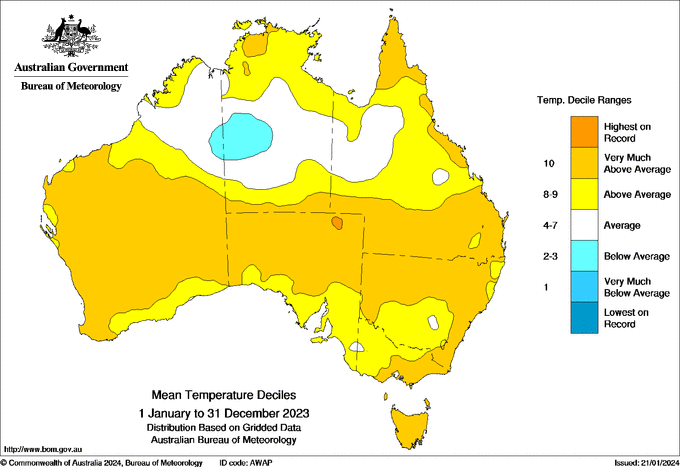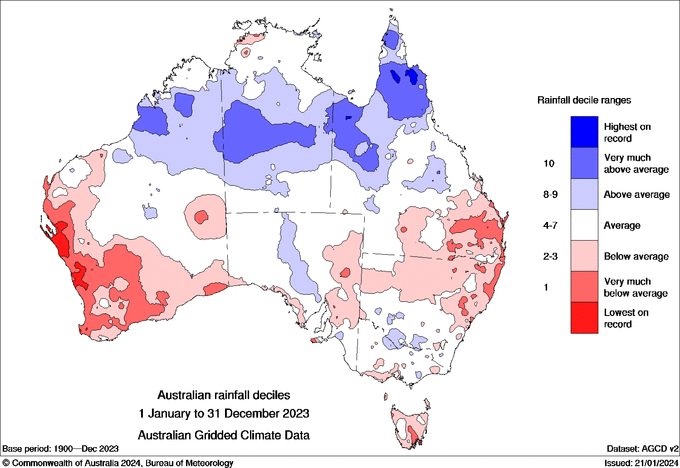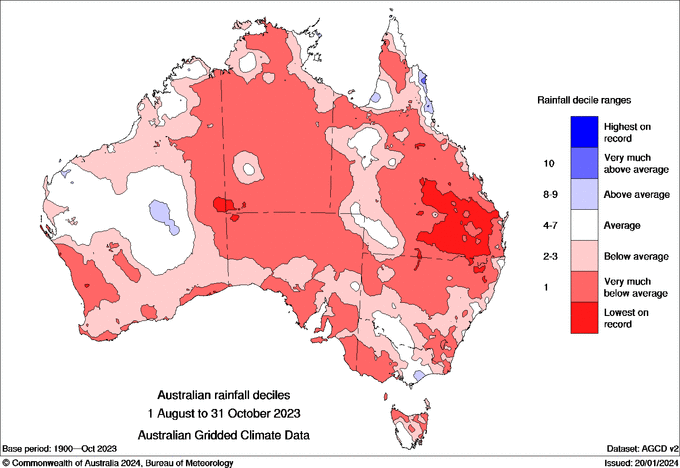Australia's 2023 in weather: a year of warm temperatures and contrasting rainfall
08 February 2024
Each year the Bureau of Meteorology releases its Annual Climate Statement. This report is the official record of Australia's climate, water and notable weather events from the previous year.
The Annual Climate Statement for 2023 shows the year was warmer than average for Australia. While rainfall was close to average for Australia overall, it was a year of contrasts with above average rainfall in the north and below average rainfall in the south. Globally, 2023 was the world's warmest year on record.
Video: Watch this short video for an overview of Australia's climate in 2023.
Australia experiences another year of above average temperatures
In 2023, the annual mean temperature was 0.98 °C above the 1961–1990 average. This made 2023 the equal eighth–warmest year on record, since temperature records began in 1910, and the warmest year since 2020.
The national mean maximum daytime temperature was 29.89 °C. This is 1.34 °C warmer than the 1961-1990 average. This makes 2023 the equal fiftth-warmest year on record for maximum temperatures. Mean maximum and minimum temperatures were also above average for all states and the Northern Territory.

Map: Australia's mean temperature in 2023.
In Australia, warm conditions prevailed for much of the year. From July to December, the national mean temperature was in the top 10 warmest on record for each respective month. The exception was October, which was the fifteenth warmest October on record.
Spring 2023 was Australia's 5th warmest on record. The overall mean temperature for spring was 1.69 °C above the 1961–1990 average. This followed our warmest winter on record, with the overall mean temperature 1.53 °C above the 1961-1990 average.
Wet in the north, dry in the south
It was a year of contrasts for rainfall, with above average rainfall across much of the north, but below average across parts of eastern, southern and Western Australia.
New South Wales, Victoria, South Australia, Western Australia and Tasmania all had below average rainfall overall. Only Queensland and the Northern Territory had above average rainfall.
Australia's average total rainfall in 2023 was 474.02mm. This is 1.6% above the 1961–1990 average of 466.0mm. However there were large differences between the north and south of the country.

Map: Australia's mean rainfall in 2023.
In parts of northern and western Queensland, central parts of the Northern Territory and north-west Western Australia rainfall was in the highest 10% of historical observations. Heavy rainfall from tropical lows, including severe ex-Tropical Cyclone Ilsa and ex-Tropical Cyclone Jasper, contributed to the above average rainfall in these areas.
For parts of southern Australia, rainfall was below average. In areas of western and southern Western Australia, south-eastern Queensland, north-eastern New South Wales and eastern Tasmania rainfall was in the lowest 10% of historical observations. Parts of Gascoyne and central-west districts in Western Australia had their lowest rainfall on record.

Map: Australia's mean rainfall August to October 2023.
Dry conditions persisted across most of the country during winter and spring. August to October 2023 was Australia's driest 3-month period on record since national observations began in 1900. September 2023 was the driest September on record with total rainfall 70.2% below the 1961–1990 average. It was also the second-driest month since national rainfall records began in 1900, behind April 1902.
Water resources
Rainfall conditions affected streamflows across the country. In southern parts of Australia, surface water storage levels decreased in many areas. This included storages in the Murray–Darling Basin and south-eastern Queensland. Despite these decreases, the total surface water storage volume at the end of 2023 remained high at 74.1% of accessible capacity.
Climate influences on Australia
The major feature of the climate of 2023 was extreme and record-breaking warmth in the global oceans, record-breaking warmth for combined land and ocean temperatures and a large reduction in annual sea ice around Antarctica.
The year was characterised by a combination of climate influences affecting weather and climate conditions across Australia. The year began with La Niña weakening and returning to neutral conditions in autumn. El Niño and a positive Indian Ocean Dipole were established in early spring.
El Niño and the positive IOD were just some of the many influences on Australian rainfall in 2023. The Southern Annular Mode and very warm sea surface temperatures, particularly in the Tasman Sea, also influenced Australian climate.
As well as these climate influences, Australia is increasingly affected by global warming. Australia's climate has warmed on average 1.50 ± 0.23 °C between the start of national temperature records in 1910 and 2023. Most of this warming has occurred since 1950.
Notable weather events
There were a number of different weather events across Australia in 2023 leading to rainfall, heatwaves and bushfires.
In early January ex-Tropical Cyclone Ellie brought intense rainfall leading to significant flooding in Western Australia and the Northern Territory. In late March to early April extreme multi-day rainfall resulted in floods in north-eastern Northern Territory and north-western Queensland.
Impacts from record low rainfall throughout August to October and above average temperatures through September and October contributed to extensive fires across Australia, including large parts of Western Australia, the Northern Territory, New South Wales and Queensland.
From October to December parts of northern and central Australia were affected by frequent low-to-severe intensity heatwave conditions.
The year ended with ex-Tropical Cyclone Jasper in December bringing intense rainfall, flooding and storm surges in far-north Queensland.
More information
For more information on the Annual Climate Statement 2023 or to revisit past statements, visit our website.
Subscribe to receive climate information by email.



Comment. Tell us what you think of this article.
Share. Tell others.